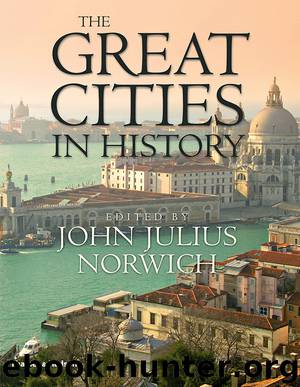The Great Cities in History by John Julius Norwich

Author:John Julius Norwich
Language: eng
Format: epub
Publisher: Thames & Hudson
Published: 2016-01-20T16:00:00+00:00
KYOTO
Pleasure Gardens and Vermilion Palaces
LESLEY DOWNER
When you look out over the present Kyoto from the west gate of Kiyomizu Temple, you see such long crowded rows of white-walled storehouses that in summer, in the early sunlight, the city sparkles as if on a snowy morning. The opulence of the era is manifested by silent pines and by cranes diverting themselves among the clouds … Smoke rises, morning and night, from the kitchen fires of all sorts of tradesmen.
IHARA SAIKAKU, 1686
For most of its thousand-year history, the city we now know as Kyoto was called simply Miyako – the Capital. For all but a few of those centuries, however, power lay elsewhere. But Kyoto was the seat of the emperor, who was of divine descent, and it was therefore a sacred city, revered as the capital.
Kyoto was founded in 794 by Emperor Kammu, who chose for his new capital a location which fitted the rules of geomancy: a broad bowl-shaped valley surrounded by tree-clad hills, bordered by sparkling rivers to east and west. He named it Heian-kyo – the Capital of Peace and Tranquillity. Poets called it the City of Purple Hills and Crystal Streams. Modelled on Chang’an, the fabled capital of China’s great Tang dynasty (p. 99), the streets were laid out in a grid pattern, with the imperial palace, the home of the emperor, to the north and the Rashomon gate guarding the south.
Heian-kyo was a city of vermilion-painted palaces where noblemen and princes rumbled along the boulevards in lavishly decorated ox carts and spent their days writing poems, mixing incense and conducting elaborate courtships. This jewel-like civilization left one remarkable monument – the world’s first novel, The Tale of Genji, written by a court lady in the 11th century, which depicts the lives and loves of those pampered courtiers.
Then in 1194 the first of a succession of warlords snatched power. Heian-kyo went up in flames. By the 16th century the city was known simply as Miyako, and the emperors had been reduced to penury. In 1600, after four centuries of war, Tokugawa Ieyasu defeated his rival warlords at the battle of Sekigahara. The emperor conferred on him the title of shogun, recognizing him as ruler of all Japan.
With peace came prosperity. Ieyasu ruled from his headquarters in the small fishing village of Edo, which quickly grew into a vast city; it would later be known as Tokyo (p. 334). But Kyoto, the sacred city, remained the capital, and there – among its aristocrats and nobles, its merchants and entertainers – began an extraordinary flowering of culture such as had not been seen since the golden days of the Heian period. The Dutch doctor Engelbert Kaempfer, who visited in 1691, found a city of some 3 million people which, he wrote, ‘serves as the storehouse of all Japanese workmanship and trade’.
To consolidate his power, Ieyasu initiated a vast building programme. In Kyoto he ordered his defeated rivals to build him a spectacular castle. Lavishly decorated with coffered ceilings, carved
Download
This site does not store any files on its server. We only index and link to content provided by other sites. Please contact the content providers to delete copyright contents if any and email us, we'll remove relevant links or contents immediately.
| Africa | Americas |
| Arctic & Antarctica | Asia |
| Australia & Oceania | Europe |
| Middle East | Russia |
| United States | World |
| Ancient Civilizations | Military |
| Historical Study & Educational Resources |
Cecilia; Or, Memoirs of an Heiress — Volume 1 by Fanny Burney(32495)
Cecilia; Or, Memoirs of an Heiress — Volume 2 by Fanny Burney(31909)
Cecilia; Or, Memoirs of an Heiress — Volume 3 by Fanny Burney(31893)
The Secret History by Donna Tartt(18947)
Sapiens: A Brief History of Humankind by Yuval Noah Harari(14320)
Leonardo da Vinci by Walter Isaacson(13235)
The Radium Girls by Kate Moore(11973)
Sapiens by Yuval Noah Harari(5323)
How Democracies Die by Steven Levitsky & Daniel Ziblatt(5172)
The Wind in My Hair by Masih Alinejad(5056)
Homo Deus: A Brief History of Tomorrow by Yuval Noah Harari(4871)
Endurance: Shackleton's Incredible Voyage by Alfred Lansing(4719)
Man's Search for Meaning by Viktor Frankl(4503)
The Silk Roads by Peter Frankopan(4489)
Millionaire: The Philanderer, Gambler, and Duelist Who Invented Modern Finance by Janet Gleeson(4421)
The Rape of Nanking by Iris Chang(4167)
Joan of Arc by Mary Gordon(4055)
The Motorcycle Diaries by Ernesto Che Guevara(4051)
Hitler in Los Angeles by Steven J. Ross(3923)
